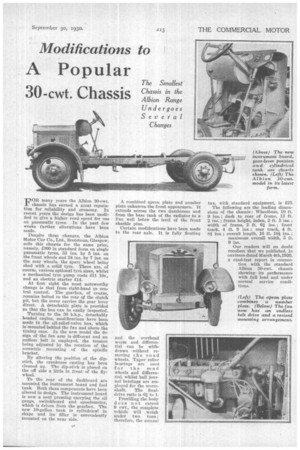Modifications to
Page 63

If you've noticed an error in this article please click here to report it so we can fix it.
A Popular
30-cwt. Chassis
The Smallest Chassis in the Albion Range Undergoes Several Changes
FOR many years the Albion 30-cwt. chassis has earned a great reputation for reliability and economy. In recent years the design has been modified to give a higher road speed for use on pneumatic tyres. In the past few weeks further alterations have been made.
Despite these changes, the Albion Alotor Car Co., Ltd., Scotstoun, Glasgow, sells this chassis for the same price, namely, £360 in standard form on single pneumatic tyres, 33 ins. by 5 ins, on the front wheels and 34 ins. by 7 ins, on the rear wheels, the spare wheel being shod with a solid tyre. There are, of course, various optional tyre sizes, whilst a mechanical tyre pump costs £11 10s., and an electric starter £14.
At first sight the most noteworthy change is that from right-hand to central control. The gearbox, of course, remains bolted to the rear of the clutch pit, but the cover carries the gear lever direct. A. detachable plate is provided so that the box can be easily inspected. Turning to the 36 b.b.p., detachably headed engine, modifications have been made in the oil-relief-valve box, which is mounted behind the fan and above the timing case. In the new model the design of the fan arm is different and an endless belt is employed, the tension being adjusted by the rotation of the eccentric mounting of the spindle bracket.
By altering the position of the dipstick, the crankcase casting has been cleaned up. The dip-stick is placed on the off side a little in front of the flywheel.
To the rear of the dashboard are mounted the instrument board and fuel tank. Both these components have been altered in design. The instrument board is now a neat pressing carrying the oil gauge, switchboard and speedometer, which is driven from the gearbox. The new 10-gallon tank is cylindrical in shape and its filler is conveniently mounted on the near side.
A combined apron plate and number plate enhances the front appearance. It extends across the two dumbirons and from the base tank of the radiator to a line well below the level of the front shackle pins.
Certain modifications have been made to the rear axle. It is fully floating
and the overhead worm and differential can be withdrawn without removing the road wheels. Taper roller bearings are used for the road wheels and differential, whilst ball journal bearings are employed for the wormshaft. The finaldrive ratio is 61 to 1.
Providing the body does not exceed 9 cwt., the complete. vehicle will weigh under two tons ; therefore, the annual tax, with standard equipment, is £25.
The following are the leading dimensions of the chassis: Wheelbase, 10 ft. 9 ins.; dash to rear of frame, 13 ft. 2 ins.; frame height, laden 2 ft. 3 ins.; width of frame, 2 ft. 6i ins.; front track, 4 ft. 9 ins. ; rear track, 4 ft. 84 ins.; overall length, 16 ft. 10lt ins.; maximum overall width, 5 ft. 9 ins.
Our readers will no doubt recollect that we published, in ourissue dated March 4th,1930, a road-test report in connection with the standard Albion 30-cwt. chassis showing its performance with full load and under normal service conditions.




















































































































